< Previous
A TRIAL IS RESPECTFULLY SOLICITED:
Advertisers in Sneinton Parish Magazine: 1901-1910
Part 2. We please thousands; sure to please YOU
By Stephen Best
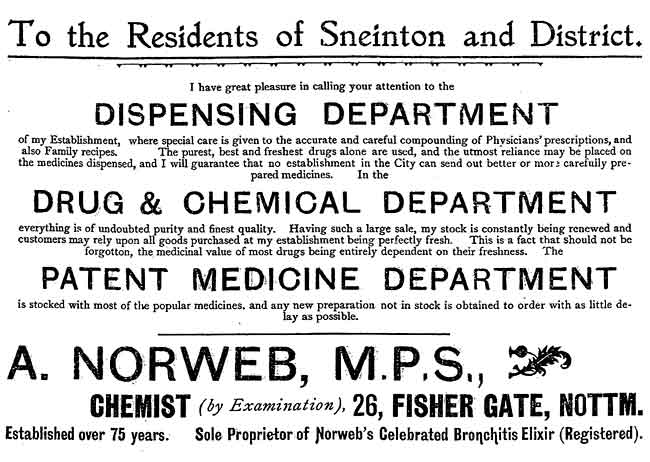
(Part One of this article appeared in Sneinton Magazine 88)
OUR NEXT TWO ADVERTISERS IN Sneinton Parish Magazine were active in what we might now term the health care business. In the first month of the twentieth century, readers were treated to the earnest recommendation, by A.W. Norweb MPS, of his own pharmacy at 26 Fisher Gate. 'To the residents of Sneinton and District. I have great pleasure in drawing your attention to the Dispensing Department of my establishment, where special care is given to the accurate and careful compounding of physicians' prescriptions, and also family recipes. The purest, best and freshest drugs alone are used...and I will guarantee that no establishment in the city can send out better or more carefully prepared medicines...'
In commending his Drug & Chemical Department, Norweb further stressed how fresh his ingredients were: 'This is a fact that should not be forgotten [sic], the medicinal value of most drugs being entirely dependent on their freshness.' Norweb described himself as 'Chemist (by examination,)' and 'Sole proprietor of Norweb's Celebrated Bronchitis Elixir.'
It is puzzling that he never reappeared in the parish magazine, since he stayed in business in Fisher Gate until after the Great War. Like some others of his day who earned a comfortable living in Sneinton, Norweb's home was elsewhere - in Melton Road, West Bridgford. By the time he closed down his shop, the houses of many of his old customers had disappeared through redevelopment; the Carter Gate/Manvers Street area, which must have provided him with plenty of trade, had indeed been completely obliterated.
Just around the corner from Norweb was the Carter Gate practice of Isaac Jeffries Dadley, the self-styled 'People's Dentist.' His father Elijah had traded here for years as a botanic druggist and herbalist, and I.J. Dadley set up next-door to him in the late 1880s. He remained in Carter Gate for about fifteen years, until moving his dental surgery to the much grander surroundings of South Parade.
Dadley's trade mark was his use of arresting advertisements, often depicting a set of grinning false teeth. His parish magazine announcements, however, were usually comparatively sober, perhaps the most entertaining of them appearing, like the photograph of Price & Beal's shop, in the summer of 1900. It showed a robed figure in a long wig, holding a quill pen. The caption ran: 'Are you a good judge? Their own reward. A really good and reliable set of teeth are, to their owners, literally well worth their weight in gold. The proper mastication of food is one of the essentials to the enjoyment of life...No matter how far short of perfection your own particular dental apparatus may be, Mr Dadley is prepared to put you right, and that at a trifling outlay.'
Like Norweb in Fisher Gate, Dadley was sufficiently go-ahead to have the telephone installed before the close of the 19th century; unlike the chemist, however, he was never, so far as can be discovered, the possessor of formal qualifications. He must, though, have given ample satisfaction to a generation of toothache sufferers, and was still in practice at South Parade in the 1920s, with his home at Mansfield Road, Carrington.5
The site of I.J. Dadley's dentist's office at 19-21 Carter Gate is, at the time of writing, close to the junction of Lower Parliament Street and Stanhope Street, opposite the Ice Arena. Further radical alterations are proposed for this locality, however, and the place may soon change once more out of all recognition.
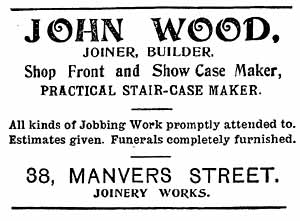
When, in addition to chemists and dentists, all others have proved unavailing, there remains one profession universally called upon. Three representatives of this essential trade advertised their services in the Edwardian parish magazine. The earliest was John Wood, whose joinery works were at 38 Manvers Street. Wood was a versatile craftsman: 'Joiner, builder, shop front and show case maker, practical stair-case maker. All kinds of jobbing work promptly attended to. Estimates given. Funerals completely furnished.'
Wood worked from 38 or 38a Manvers Street until 1905, but his premises were soon afterwards swept away in the clearance of most of the buildings on his side of the street. The carriageway was widened considerably, and later, in the 1920s, 'the new bus and tram depot further engulfed the site of Wood's works. The adjective 'practical' crops up more than once in these advertisements: one wonders, though, how anyone could ever made a living as an impractical staircase maker.
Unlike John Wood, Thomas Bottomore of 20 Sneinton Street seems to have been a funeral director pure and simple. He advised potential clients in June 1905 that he stocked 'Wreaths and globes in great variety.' Bottomore had been in business here since the 1880s, and would continue into the early twenties. His premises were next-door to the Crown & Anchor pub, just across the road from Pullman's. The location of his shop, close to that of Flint's bakers, is probably under Lower Parliament Street in front of the Ice Arena, and near the foot of Hockley.
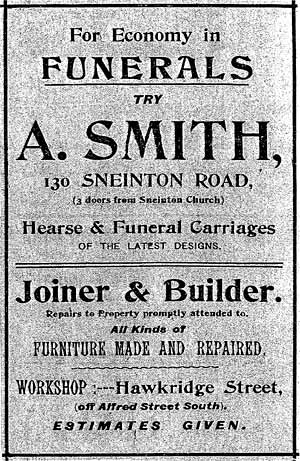
The third member of this triumvirate was Arthur Smith of 130 Sneinton Road, or, as he reminded readers of the parish magazine, '3 doors from Sneinton Church.' Somehow it seems quite acceptable for a stationer to tell you, as Hainsworth did6, that his shop is only four doors from the church, but uncommonly disquieting when an undertaker emphasizes that he is even closer.
Smith, who boasted 'Hearse and funeral carnages of the latest designs,' was, like John Wood, a man of parts. Also a joiner and builder, he made and repaired furniture at his Hawkridge Street workshop, off St Ann's Well Road. His shop in Sneinton Road was to have an interesting succession. Smith traded here for three or four years only, to be followed by a hardware dealer and then a hairdresser. By 1920, however, the undertakers were back, in the person of George W. Birch, who proved so useful to the Sneinton community that his family firm of joiners remained there until the wholesale redevelopment of Sneinton Road at the end of the 1950s.
If cleanliness is indeed next to godliness, it is appropriate that laundries should advertise in a parish magazine. Edwardian Sneinton was not short of folk glad to take in other people's washing, and some brisk claims were made by three firms operating in the neighbourhood. The Trent Laundry, whose works were in Old Lenton, took a full-page in March 1902 to offer: 'All classes of laundry work. Shirts, collars, and cuffs a speciality. Lace & muslin curtains equal to new and at reasonable prices.' In addition to providing a daily van collection, Trent Laundry possessed two branch receiving offices in Sneinton. One was Barber's tobacco shop at 27 Southwell Road, the other at 44 Belvoir Crescent, in the person of a Mrs Ritchie.
The unfamiliar name Belvoir Crescent was for a year or two applied to a part of Lees Hill Street, on the left-hand side of the hill leading up to Manor Street. Only the most imaginative developer or builder could have dreamed up the description 'Crescent' for a row of houses that was nothing of the kind. Mrs Sarah Ann Ritchie's laundry agency was her confectionery shop at the top of Lees Hill Footway; its site is now a little play area and open space for children. A few months later, the Southwell Road office had gone, leaving her as Sneinton's sole representative of the Trent Laundry, who now added 'Dyers and French cleaners' to their credentials.
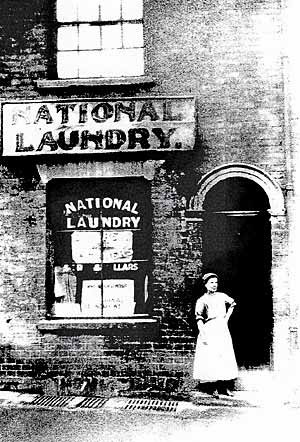 THE NATIONAL LAUNDRY receiving office at 98 Sneinton Road, about 1918.
THE NATIONAL LAUNDRY receiving office at 98 Sneinton Road, about 1918.A rival operator appeared in May 1904: the National Laundry, of Briar Street in the Meadows. They listed three receiving offices in Sneinton; 68 Trent Road (now Carole Start, ladies' hair stylist): Mrs Budge's general shop at 16 Sneinton Dale: and our old acquaintance Mrs Ritchie. As we do not again see a Trent Laundry advertisement, it is possible that the National had supplanted this firm in the locality. Sneinton readers were promised 'High-class family work. Collars and shirts a speciality.. Tablecloths &c. repaired by experienced hands.' During the following year possible patrons were assured that: 'The extensive premises of this laundry have been specially erected for high-class family work, [that phrase again] and are fitted throughout with the most modern and sanitary appliances...'
In the summer of 1905 the laundry asked a question, to which it supplied the answer. 'Do you know who are our best customers? Not necessarily those who spend the most money, but those who wear the shirts and collars got up at this Laundry - the more friends these people have, the better the customers they are for us. They talk about the perfect finish which we impart to their linen.'
The parish magazine for January 1909 featured a photograph of the interior of the National Laundry works; unhappily this picture was so dark and muddy that little could be discerned. Some laundering prices were quoted: collars 9d a dozen, and shirts 3d each. Mrs Ritchie had by now ceased to act as a branch office, being replaced by one at 98 Sneinton Road.
The third laundry was more local in every respect, its works and owner based in Sneinton. The Manor Laundry was situated at the town end of Sneinton Hermitage, in the building now called Hermitage House, abutting on to Lees Hill Footway. The proprietor William Saxton lived next door at no. 1, 'Oak Leigh.' In January 1907 his parish magazine advertisement urged: 'If you have not already given us a trial, please do so. We please thousands; sure to please YOU.’
Next month’s issue suggested even more reasons why Sneinton people should entrust their washing to the Manor Laundry (telephone no. 2922x). 'Owing to our large increase in business we have opened the above premises, where we hope to meet the demands on our resources. The above premises have been built specially for a laundry, the sanitary arrangements being made perfect. We have also installed the most modern (1907) appliances for turning out all classes of laundry work. We hope to retain the same reputation as with shirts and collars - second to none. Special quotations for hotels and large family washing.'
There were few hotels in Sneinton to respond to this last offer, but it is possible that 'hotels' also included pubs, whose existence was of course never recognized by the Edwardian Sneinton Parish Magazine. One that did exist (and still does) may have been doubly beyond the pale, as far as the magazine was concerned. Not only did the Earl Manvers Hotel in Colwick Road sell strong drink, but it had been built in order to accommodate visitors to the nearby racecourse, opened in 1892.
By 1908 the Manor Laundry had three local agents: in Newark Street, Sneinton Road and Moreland Street. These had evidently become so familiar, that in January 1909 the advertisement dispensed with their addresses, displaying instead a drawing of a clown, examining his reflection in his shirt cuff. The caption ran: 'The cuff is a mirror when done at the Manor Laundry.' These sales initiatives evidently found their mark; the Manor Laundry was still going strong in the 1920s, with offices in Sneinton, Radford and Forest Fields.
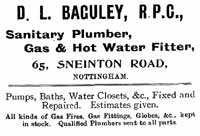 D L BAGULEY’S 1905 advertisement from 65 Sneinton Dale (Minerva Terrace), and a 1950s snapshot of his later premises, just two doors away at number 69.
D L BAGULEY’S 1905 advertisement from 65 Sneinton Dale (Minerva Terrace), and a 1950s snapshot of his later premises, just two doors away at number 69.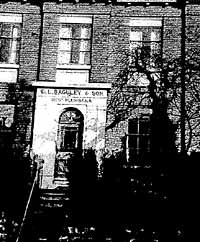
Two representatives of another indispensable craft publicized their services in the magazine. One was to prove a most enduring business: the other appeared briefly, and disappeared without trace. In March 1903 David Lawrence Baguley of 60 Sneinton Road announced himself as: 'Sanitary plumber, gas and hot water fitter.Pumps, baths, water closets, &c. fixed and repaired. Estimates given. All kinds of gas fires, gas fittings, globes &c. kept in stock. Qualified plumbers sent to all parts.'
Baguley's last few words conjure up the mental picture of an expeditionary force of plumbers, tool bags and handcarts at the ready, waiting to be summoned to remote outposts of Empire. By 1905 he had crossed over Sneinton Road to no. 65, one of the imposing row called Minerva Terrace, where he remained until the 1920s. After moving a couple of doors to no. 69, the firm traded as D.L. Baguley & Sons until the terrace was demolished about 1960.
By contrast, Wright & Reeve of 3 Manor Street seems to have been a partnership which broke up soon after it began. Their advertisements in the latter part of 1907 closely resembled Baguley’s, with the added details that they were glaziers, and fitted 'Baths, lavatories and water closets on all the latest principles.' Henry Wright was listed in the 1910 street directory as a plumber, but before and after this date we find only Mrs Ann Wright. No plumber's yard ever existed at 3 Manor Street, which is today, as it always has been, a private house.
Another advertiser made his sole appearance in January 1909: '40 Sneinton Hermitage. Needham's for incandescents. All best kind of mantles for upright and inverted stocked. Large variety of globes, shades, chimneys, burners, etc.' We may conclude that John Charles Needham wrote his own advertising copy, and was not one of the more gifted prose stylists among Sneinton tradesmen. It seems that gas light fittings were merely a side line for him, as Needham figured in directories between 1905 and 1913 as a painter. Like Wright & Reeve's, his business address was, and remains, a private dwelling house. Presumably Needham too stored his gas mantle fittings and painting materials in a shed, or on premises away from his home.
Coal was a commodity in universal demand in Sneinton a hundred years ago, virtually every house depending on open fires. Two coal dealers advertised in the pages of the parish magazine, both with other business sidelines to fall back on. First came a well-established firm, already here for more than five decades. 'Coal Wharf, Hermit Street, Nottingham. Samuel Eyre & Co., (A. Blasdale,) Coal, corn, hay and straw merchants. All orders promptly attended to. Truck loads to any station.'
Hermit Street lay between Manvers Street and the truncated Earl Manvers canal branch to Sneinton. Since the turn of the century it had been overshadowed by the viaduct which took the Great Northern line into Victoria Station. Beyond the railway loomed the gas works. Until 1929 this less than idyllic spot was the incongruous and inconvenient location of Sneinton Public Library and Reading Room. Closed as a thoroughfare during the Second World War, Hermit Street was subsequently taken over by the Boots factory complex. Gradually obliterated over the following years, its site is now under the edge of the Island Business Quarter.
Eyre was a well-known Sneinton name over many generations, but by 1909, when the advertisement was placed, the firm had a different owner. This was Arthur Blasdale, who was still in charge at Hermit Street in 1920, although he lived at rural Bassingfield rather than in grimy Sneinton. Samuel Eyre & Co. continued in business until the end of Hermit Street, about 1942.
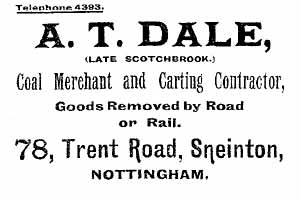 Traces of DALE’S PAINTED ADVERTISEMENT on his old shop are still visible at the time of writing, but are likely to disappear very soon, when the building is converted to a new use.
Traces of DALE’S PAINTED ADVERTISEMENT on his old shop are still visible at the time of writing, but are likely to disappear very soon, when the building is converted to a new use.78 Trent Road was an address long connected with the coal trade. The March 1910 magazine included an announcement sent in from here by 'A.T. Dale (late Scotchbrook). Coal merchant and carting contractor, goods removed by road or rail.' Dale was clearly a go-ahead man, as the mention of 'Telephone 4393' attests. After the Great War his business continued in Trent Road and around the corner in Bleasby Street. Dale and his wife Mary Sydney Dale had both gone by the outbreak of the Second World War, however, when another coal dealer, Arthur Woodward, was in command at 78 Trent Road.
And 'late Scotchbrook'? For a couple of years from 1905 Tom Scotchbrook had traded here as a furniture remover and coal merchant. Quite a kick accompanied the realisation, in May 2003, that the remains of painted signs exist high on the wall of 78 Trent Road: the words T. Scotchbrook: Removals: Carting,' can, with the benefit of hindsight, still be made out after almost a century.
With so much house coal being burned in Sneinton, it was inevitable that chimney sweeps should be kept busy. It is strange that no more than one of them promoted his services in the parish magazine. The advertisement of W. Blockley, 1 Camden Street, Sneinton Road, suggests a dignified, self-respecting man, as befitted the proprietor of a business established in 1836. Blockley, who had recently moved from Platoff Street in the Meadow Platts, told prospective customers that he was a 'Practical chimney sweep... Chimneys, stoves, flues, and heating apparatus of all descriptions thoroughly cleaned. Workmanship and cleanliness guaranteed. Ensure your work being done by practical men of the Old School.'
We note that word 'practical' again: indeed, Blockley used it twice. This was no doubt reassuring to customers, but once again, it is hard to imagine a theoretical chimney sweep. One is glad to learn, though, that there existed an 'Old School' of chimney sweeping technique, and that it flourished in Sneinton. The Blockley business dynasty failed only narrowly to achieve its centenary; William was still plying his trade in 1928, but by 1936 Mrs Ellen Blockley was living alone at 1 Camden Street.
Attention now turns to someone who, while a prominent businessman, gained equal distinction in other aspects of life. An advertiser in the parish magazine over many years, he reminded readers in January 1901 to: Buy your brushes from the maker, W. Kiddier, 25 Sneinton Street, telephone number 678.' William Kiddier's father had set up a brushmaking works and retail shop at this address, in what became the 'Pullman's block.' He and his family lived over the shop for a time, before moving house to Alfred Street South.
William Kiddier junior, whom we celebrate here, was something of a Renaissance man, achieving note as brushmaker, writer, and artist. Prior to 1904 he lived at various addresses in the Sneinton area; in 1891 at Promenade, off Robin Hood Street: in 1898 at Victoria Avenue, off Sneinton Dale: a few years later in Victoria Villas, Sneinton Dale. Early in the twentieth century he opened his prestigious brush shop in South Parade, with his studio situated at the top of the building. Kiddiers continued to make and sell brushes at Sneinton Street until the 1920s, their premises eventually being taken over by the ever-expanding Pullmans.
On retiring from brush manufacturing in 1923, William Kiddier disposed of his South Parade shop to the Royal Midland Institution for the Blind, who ran it as part of their own brush business. Having already established a minor reputation as a poet, and a very much more substantial one as an artist, Kiddier turned to writing about his own professional craft. First came a small book, 'The brushmaker,' then, in his seventies, he published 'The old trade unions, from unprinted records of the brushmakers.' In both volumes, Kiddier's socialist principles and deep sympathy for the working man are strongly expressed. These were all the more remarkable, coming from one who, as an employer, had been head of a prosperous business.
William Kiddier died in 1934, and was buried in Redhill Cemetery. Thirty-five years later, following the death of his daughter, an exhibition of Kiddier's drawings and paintings was staged at Victoria Street Gallery in Nottingham. In his lifetime he had seen his works shown in London, Glasgow, and Hull, in addition to a one-man exhibition at Nottingham Castle. Of special interest to Sneinton is his work for the short-lived periodical City Sketches. In 1898 Kiddier illustrated his own articles about Sneinton Hermitage and Sneinton Market with pen and ink drawings of the Manor House, the Hermitage, and Dale Street, and of the lively characters he had observed in the market. A more detailed account of his attainments, especially in the artistic and literary fields, appeared in a previous issue of Sneinton Magazine.7
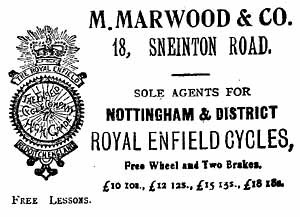
A new note was introduced to the parish magazine in May 1903 by M. Marwood & Co. of 18 Sneinton Road, who described themselves as: 'Sole agents for Nottingham & District: Royal Enfield Cycles, free wheel and two brakes. £10.10s., £12.12s., £15.15s., £18.18s. Lessons free.' Two things stand out here. First, a good bicycle could be very expensive a century ago. In today’s terms 18 guineas would be worth something over a thousand pounds, and in 1903 would have represented many weeks' wages for the ordinary working man - an urban labourer's pay averaged about 30/- (£1.50p) a week at that date. Secondly, Marwoods (Marwood & Cross before the turn of the century) found it worth their while to attract purchasers with the offer of free lessons; how thorough and protracted these were we cannot tell. It would also be interesting to know where aspirant cyclists were taken to practise falling off. Not in Sneinton’s cobbled streets, surely?
Displaying the Royal Enfield badge on their advertisement, Marwoods remained at 18 Sneinton Road until shortly before the Great War. A cycle agent named Thursby followed, but by 1920 the premises had been taken over by Claringburn and Codd, who were in business as motor engineers until the 1990s. Tyre Zone, who trade here today, maintain no. 18’s connection with road vehicles.
A very different sort of service was advertised in June 1905 by 'Miss Ryde' of 12 Victoria Villas, Sneinton Dale, 'Teacher of the pianoforte and theory of music.' This address is now 57 Sneinton Dale, but soon after 1905 the Rydes moved the few yards to 6 Victoria Villas (now no. 45) at the corner of Holroyd Avenue. The head of the family, Gilbert Ryde, was a commission agent in the family firm H.S. & G. Ryde, of Commerce Square in the Lace Market. Miss Frances Ryde was to spend several decades teaching music at 45 Sneinton Dale, and was still there at the beginning of the 1950s. During the years that Miss Minnie Bentley, singing teacher, was in practice two doors away from her, this must have been a melodious quarter of Sneinton.
None of the remaining trio of local traders placed an advertisement in Sneinton Parish Magazine before 1909. There seems to have been an attempt at the time to raise extra revenue for the magazine, resulting in a noticeable influx of new advertisers for the January issue of that year.
Herbert Palethorpe, of 109 Sneinton Road was a 'Practical boot and shoe maker and repairer. Repairs sent for.' His premises were at the corner of Camden Street, close to where the present row of shops stands at the top of Sneinton Road. A few years later Palethorpe moved the minimum possible distance, to no. 111, but after 1920 we lose trace of him. It is interesting that he offered to collect boots and shoes for repair: only the most comfortably-off Sneinton residents would be have been able to afford such a service. The poorest would tackle the job themselves in back yard or cellar.
W.C. Osgarby's shop at 9 Southwell Road stood at the junction with Pipe Street, one of the streets of back-to-back houses which ran to Gedling Street. His line was: 'Furnishing ironmonger, cutler, etc. Electro-plated and nickel silver spoons and forks. Special value in travelling trunks.' Some of these relatively superior goods must have been aimed at customers better off than anyone living in Pipe Street or its immediate neighbours. A resident of Colwick Road, William Conrad Osgarby remained in business until the Great War. By 1920, however, Mrs Kate Eliza Osgarby, presumably widowed, was running the shop. Along with nearly everything else on that side of Southwell Road, it was pulled down in the middle 1930s to make way for the new wholesale market. Peggers' Inn alone survives from an earlier period.
Last of all the shopkeepers was Alfred Bates: 'Watchmaker & Jeweller, 62 Sneinton Hermitage. Repairs done on the shortest notice at our own premises. Old jewellery renovated and made to look like new. Specialities:- Gilding and plating executed on the premises. Old Jewellery bought. Orders called for.' Prior to 1909 Bates had plied his trade in Pennyfoot Street, but in spite of the comprehensive range of services offered by him, his tenure in Sneinton Hermitage was to be quite short. 1913 found another watchmaker, Joe A. Bennett, at the shop; Bennett's business was evidently a sound one, as he was still active here at the beginning of the Second World War. The row which included all the shops in Sneinton Hermitage now presents a very forlorn appearance, all the former retail premises being empty, or converted into private dwellings. No. 62 is currently disused, though still recognizably an old shop; it most recently housed the Trent Dog Parlour.
One further advertisement must be recorded. This was exceptional, as the only one in Sneinton Parish Magazine between 1901 and 1910 inserted by a private advertiser, as opposed to a tradesman or professional. The April 1904 number contained the following announcement: 'For sale! Bath chair, (wicker) good condition, 35/-. Cycle, Campion, green enamel frame, ridden only a few times, with stand, price £3. Apply by letter to : Mr A.E. Beaumont, 17 Ashfield Road.'
This notice did not reappear, so it may be assumed that buyers came forward promptly. One says buyers, rather than a buyer, since it seems unlikely that any one person would require a bath chair and a bicycle at the same time. Mr Beaumont, though, desired to be rid of both, and the possibility of a sad decline consequently suggests itself. Could he have started out as a keen cyclist, only to be stricken down in some way after just a few rides? Might he indeed have been obliged to take to a bath chair, eventually becoming so enfeebled that even that mode of transport had to be given up? We hope not, yet the signs are not encouraging. A couple of years after the placing of this advertisement in the magazine, the Nottingham street directory lists Mrs Emma Beaumont as householder of 17 Ashfield Road. Of Mr A.E. Beaumont there is no sign. We must, I think, fear the worst for him.
Campion cycles and motor-cycles were, by the way, made in Nottingham. A nearly new Campion at £3 would no doubt have suited the Sneinton pocket far better than one of Marwood's high-priced machines.
Here, then, are our forty-five advertisers from Edwardian Sneinton. What, apart from a little mild entertainment, can we glean from their earnest claims and assurances? After all, local history is supposed to teach us something. For one thing, we can see that the style of English employed a hundred years ago, although rather different from today's usage, embodied essentially the same commercial message: 'Shop with us. Use our services. We are better, cheaper and more reliable!'.
Earlier in this article it was suggested that the locally-based businesses who took advertisements in Sneinton Parish Magazine were all seeking the patronage of the local community. I think this is substantially true. Businessmen advertised then - as they do now - where they believed they would obtain a favourable response. The larger concerns, like Pullmans, Price & Beal, and Kiddiers, certainly attracted custom from a larger catchment area, and advertised on a Nottingham-wide basis. They were, nonetheless, keen to highlight their Sneinton shops, and to cultivate the market on the own doorstep.
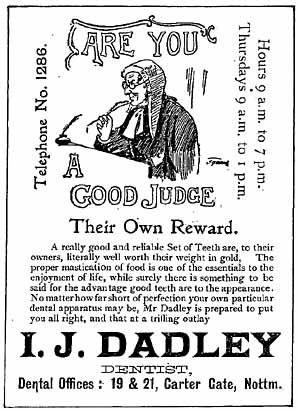
I.J. Dadley was another whose publicity appeared throughout Nottingham, and in all four of its daily newspapers. However many patients he drew from farther afield, though, there was always a crowded population of poor people with bad teeth within a stone’s throw of his Carter Gate office.
Similarly, the three laundries, although running city-wide concerns, regularly reminded people of their Sneinton branch agencies. The rapid turnover of these, and the fact that one woman acted as agent for two laundries, might suggest that in Sneinton the three were competing for an amount of business that could not support them all.
I wondered at first whether Miss Ryde could have survived on pianoforte and theory pupils from Sneinton, but concluded that, with the rising suburb of Sneinton Dale, the neighbourhood probably did contain sufficient parents who wanted their children to acquire musical skills. Perhaps these were the same families who purchased Edwards's gramophone records? Miss Ryde was here for a very long time, so it must be supposed that she got her sums right. Edwards, on the other hand, had advertised his gramophones in Sneinton so fleetingly that we must suspect a business failure on his part.
Osgarby’s high-class table cutlery and travelling trunks might have sold only slowly in Sneinton, but he undoubtedly stocked humbler lines, within the range of the less well-off, and not mentioned in his advertisement. Perhaps he thought that readers of the parish magazine generally maintained a good table.
One other advertiser merits a closer look. Very few Sneinton people in 1903 could have afforded even the least expensive of Marwood’s bicycles, so he must surely have looked elsewhere for most of his clientele. The clue lies in his advertisement: he was, remember, Royal Enfield's sole agent for Nottingham and district. We may be confident that in The Park, West Bridgford, and Mapperley Park, lived people who might think nothing of coming to Sneinton to spend nearly £20 on a cycle, while the locals had to gaze on in envy at such exotic machines.
Some of the food shops, in particular, had to depend on the loyalty of customers from a tiny area, limited almost to their own street, with rivals in the same line of business lurking just a few yards around the corner to threaten their trade. The brief existence of some of them indicates that not all survived such competition.
Several of the trades we have looked at, though prosaic enough, are not to be found here nowadays. Sneinton clings on to a few grocers, and is served by several good bakers. Fishmongers have long gone, but Sneinton Dale retains a version of the Popular Price Cafe. The butchery trade hangs on - just - but market gardeners are only a memory here.
Tobacconists and newsagents still figure among local shops, and two drapers continue to trade in Sneinton Dale. Milliners, though, seem now like something out of the ark, while urban post offices are under constant threat. Chemists, as ever, ply a brisk trade throughout Sneinton, and high-profile dental practices are again a feature of the neighbourhood.
The vocation of undertaker has in Nottingham largely become centralised, but one of its most respected firms still exists on the borders of Sneinton. Plumbers, too, are less thick on the ground than formerly - in short supply, so rumour has it. A call to Yellow Pages for a plumber can nowadays result in an outlay which would have seemed fantastic to the Edwardian advertiser.
Sadly, suppliers of gas light fittings, together with coal merchants and chimney sweeps, are for most people as irrelevant nowadays as the bow and arrow. This writer, however, in his primitive home off Oakdale Road, still calls on the services of the two last-mentioned. Shoe repairers are now as hard to find in Sneinton as milliners, while no watchmaker or jeweller trades here now. Fortunately an exemplary ironmonger thrives in Sneinton Dale.
There is, though, a reasonably frequent bus service connecting Sneinton with all the facilities of city centre shopping areas, and many local people drive in their cars to out- of-town stores. Comparisons, it is said, are odious, and perhaps we should not make too much of them.
The second part of this article has from time to time made mention of advertisers who feature more fully in part one. To anyone who has not read the first part, and wonders whether it is worth the trouble, the answer is yes. In fact, in urging any reluctant reader to tackle part one, I cannot do better than echo the words of Thomas Flint, (who appears in it): ’A trial is respectfully solicited.'
REFERENCES
5. A longer account of LJ. Dadley can be found in: It paid to advertise: 1. The People’s Dentist. Sneinton Magazine 57, Winter 1995/96.
6. See Part 1 of this article: Sneinton Magazine 88, Autumn 2003.
7. Brush and pen: William Kiddier and his work. Sneinton Magazine 42, Spring 1992.
For further information about Sneinton shops of earlier years, the attention of the reader is drawn to: More than small change: half a century of Sneinton’s shops. Sneinton Magazine 80 and 81.
John Hose kindly read the draft of this article, and offered valuable comments and suggestions. To him I extend my best thanks. Any errors are of course entirely my responsibility.
< Previous
